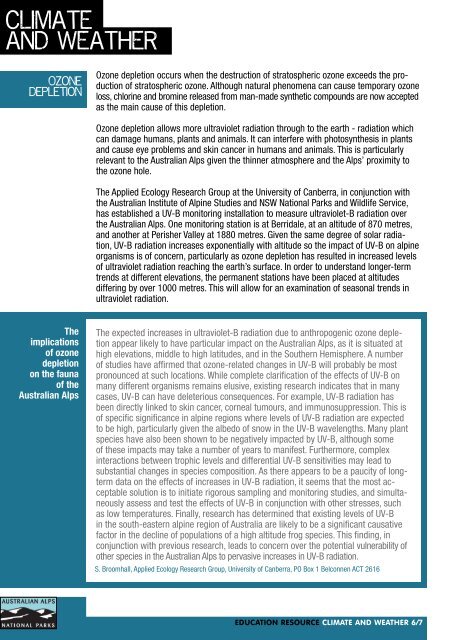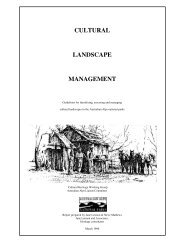CLIMATEAND WEATHEROzonedepletionOzone depletion occurs when <strong>the</strong> destruction <strong>of</strong> stratospheric ozone exceeds <strong>the</strong> production<strong>of</strong> stratospheric ozone. Although natural phenomena can cause temporary ozoneloss, chlorine <strong>and</strong> bromine released from man-made syn<strong>the</strong>tic compounds are now acceptedas <strong>the</strong> main cause <strong>of</strong> this depletion.Ozone depletion allows more ultraviolet radiation through to <strong>the</strong> earth - radiation whichcan damage humans, plants <strong>and</strong> animals. It can interfere with photosyn<strong>the</strong>sis in plants<strong>and</strong> cause eye problems <strong>and</strong> skin cancer in humans <strong>and</strong> animals. This is particularlyrelevant to <strong>the</strong> <strong>Australian</strong> <strong>Alps</strong> given <strong>the</strong> thinner atmosphere <strong>and</strong> <strong>the</strong> <strong>Alps</strong>’ proximity to<strong>the</strong> ozone hole.The Applied Ecology Research Group at <strong>the</strong> University <strong>of</strong> Canberra, in conjunction with<strong>the</strong> <strong>Australian</strong> Institute <strong>of</strong> Alpine Studies <strong>and</strong> NSW National Parks <strong>and</strong> Wildlife Service,has established a UV-B monitoring installation to measure ultraviolet-B radiation over<strong>the</strong> <strong>Australian</strong> <strong>Alps</strong>. One monitoring station is at Berridale, at an altitude <strong>of</strong> 870 metres,<strong>and</strong> ano<strong>the</strong>r at Perisher Valley at 1880 metres. Given <strong>the</strong> same degree <strong>of</strong> solar radiation,UV-B radiation increases exponentially with altitude so <strong>the</strong> impact <strong>of</strong> UV-B on alpineorganisms is <strong>of</strong> concern, particularly as ozone depletion has resulted in increased levels<strong>of</strong> ultraviolet radiation reaching <strong>the</strong> earth’s surface. In order to underst<strong>and</strong> longer-termtrends at different elevations, <strong>the</strong> permanent stations have been placed at altitudesdiffering by over 1000 metres. This will allow for an examination <strong>of</strong> seasonal trends inultraviolet radiation.Theimplications<strong>of</strong> ozonedepletionon <strong>the</strong> fauna<strong>of</strong> <strong>the</strong><strong>Australian</strong> <strong>Alps</strong>The expected increases in ultraviolet-B radiation due to anthropogenic ozone depletionappear likely to have particular impact on <strong>the</strong> <strong>Australian</strong> <strong>Alps</strong>, as it is situated athigh elevations, middle to high latitudes, <strong>and</strong> in <strong>the</strong> Sou<strong>the</strong>rn Hemisphere. A number<strong>of</strong> studies have affirmed that ozone-related changes in UV-B will probably be mostpronounced at such locations. While complete clarification <strong>of</strong> <strong>the</strong> effects <strong>of</strong> UV-B onmany different organisms remains elusive, existing research indicates that in manycases, UV-B can have deleterious consequences. For example, UV-B radiation hasbeen directly linked to skin cancer, corneal tumours, <strong>and</strong> immunosuppression. This is<strong>of</strong> specific significance in alpine regions where levels <strong>of</strong> UV-B radiation are expectedto be high, particularly given <strong>the</strong> albedo <strong>of</strong> snow in <strong>the</strong> UV-B wavelengths. Many plantspecies have also been shown to be negatively impacted by UV-B, although some<strong>of</strong> <strong>the</strong>se impacts may take a number <strong>of</strong> years to manifest. Fur<strong>the</strong>rmore, complexinteractions between trophic levels <strong>and</strong> differential UV-B sensitivities may lead tosubstantial changes in species composition. As <strong>the</strong>re appears to be a paucity <strong>of</strong> longtermdata on <strong>the</strong> effects <strong>of</strong> increases in UV-B radiation, it seems that <strong>the</strong> most acceptablesolution is to initiate rigorous sampling <strong>and</strong> monitoring studies, <strong>and</strong> simultaneouslyassess <strong>and</strong> test <strong>the</strong> effects <strong>of</strong> UV-B in conjunction with o<strong>the</strong>r stresses, suchas low temperatures. Finally, research has determined that existing levels <strong>of</strong> UV-Bin <strong>the</strong> south-eastern alpine region <strong>of</strong> Australia are likely to be a significant causativefactor in <strong>the</strong> decline <strong>of</strong> populations <strong>of</strong> a high altitude frog species. This finding, inconjunction with previous research, leads to concern over <strong>the</strong> potential vulnerability <strong>of</strong>o<strong>the</strong>r species in <strong>the</strong> <strong>Australian</strong> <strong>Alps</strong> to pervasive increases in UV-B radiation.S. Broomhall, Applied Ecology Research Group, University <strong>of</strong> Canberra, PO Box 1 Belconnen ACT 2616EDUCATION RESOURCE CLIMATE AND WEATHER 6/7
CLIMATEAND WEATHERReferencesHennessy, K., Whetton, P., Smith, I., Bathols, J., Hutchinson, M. & Sharples, J. (2003) ‘The Impact <strong>of</strong><strong>Climate</strong> Change on Snow Conditions in Mainl<strong>and</strong> Australia’, a report for <strong>the</strong> Victorian Department <strong>of</strong> Sustainability<strong>and</strong> Environment, Victorian Greenhouse Office, Parks Victoria, NSW National Parks & WildlifeService, NSW Department <strong>of</strong> Infrastructure, Planning <strong>and</strong> Natural Resources, <strong>Australian</strong> GreenhouseOffice <strong>and</strong> <strong>Australian</strong> Ski Areas Association, CSIRO Atmospheric Research, Aspendale.Kosciuszko National Park (2006) ‘Plan <strong>of</strong> Management’, New South Wales National Parks <strong>and</strong> WildlifeService, Department <strong>of</strong> Environment <strong>and</strong> Conservation, Hurstville.Pickering C, Good, R. <strong>and</strong> Green K. (2004) ‘Potential Effects <strong>of</strong> Global Warming on <strong>the</strong> Biota <strong>of</strong> <strong>the</strong> <strong>Australian</strong><strong>Alps</strong>: A report for <strong>the</strong> <strong>Australian</strong> Greenhouse Office’, <strong>Australian</strong> Government, Canberra.Stern, H., de Hoedt, G. <strong>and</strong> Ernst, J. (2000) Objective Classification <strong>of</strong> <strong>Australian</strong> <strong>Climate</strong>s, <strong>Australian</strong>Bureau <strong>of</strong> Meteorology, Melbourne.Glossaryanthropogenic: <strong>the</strong> description <strong>of</strong> something that is created by humans <strong>and</strong> is a subject <strong>of</strong> scientific study.biomes: a major regional or global biotic community, such as a grassl<strong>and</strong> or desert, characterizedchiefly by <strong>the</strong> dominant forms <strong>of</strong> plant life <strong>and</strong> <strong>the</strong> prevailing climate.climate: describes typical <strong>wea<strong>the</strong>r</strong> conditions over a period <strong>of</strong> time.conduction: <strong>the</strong> transfer <strong>of</strong> heat between bodies that are in contact.convection: <strong>the</strong> transfer <strong>of</strong> heat by currents <strong>of</strong> air or fluid.endemic: a species that is unique to that place or region <strong>and</strong> found nowhere else.glacial periods: any period <strong>of</strong> time in which glaciers covered a large part <strong>of</strong> <strong>the</strong> earth’s surface.greenhouse effect: greenhouse gases - carbon dioxide, methane <strong>and</strong> water vapour - play an importantrole in keeping <strong>the</strong> temperature <strong>of</strong> <strong>the</strong> earth’s surface at <strong>the</strong> right level by absorbing <strong>and</strong> trappingheat from <strong>the</strong> sun. Without <strong>the</strong>m <strong>the</strong> earth would be very cold. Over <strong>the</strong> past 200 years <strong>the</strong>re has beenan increase in <strong>the</strong> amount <strong>of</strong> greenhouse gases in our atmosphere, especially carbon dioxide from <strong>the</strong>burning <strong>of</strong> fossil fuels (coal, oil <strong>and</strong> natural gas). As <strong>the</strong> amount <strong>of</strong> greenhouse gases increases, <strong>the</strong>atmosphere is trapping more heat <strong>and</strong> <strong>the</strong> earth is slowly getting warmer. This is called <strong>the</strong> greenhouseeffect. This warming <strong>of</strong> <strong>the</strong> atmosphere is slowly changing <strong>wea<strong>the</strong>r</strong> patterns.mid-latitude: latitude is <strong>the</strong> measurement, in degrees, <strong>of</strong> a place’s distance north or south <strong>of</strong> <strong>the</strong> equator. Aregion’s latitude has a great impact on its climate <strong>and</strong> <strong>wea<strong>the</strong>r</strong> patterns. Mid-latitudes are those occurringmidway between <strong>the</strong> equator <strong>and</strong> <strong>the</strong> poles <strong>and</strong> tend to experience cool <strong>and</strong> temperate conditions.orographic rainfall: <strong>the</strong> dominant wind patterns force air to go up <strong>and</strong> over <strong>the</strong> mountain. As <strong>the</strong> airrises, it cools <strong>and</strong> <strong>the</strong> moisture within <strong>the</strong> air condenses <strong>and</strong> falls as precipitation.precipitation: when cloud particles become too heavy to remain suspended in <strong>the</strong> air, <strong>the</strong>y fall to <strong>the</strong>earth as precipitation. Precipitation occurs in a variety <strong>of</strong> forms; hail, rain, freezing rain, sleet or snow.transpiration: <strong>the</strong> evaporation <strong>of</strong> water from plants.tree line: The upper altitude where trees can grow. The area above <strong>the</strong> tree line is too cold for trees togrow <strong>and</strong> is known as <strong>the</strong> alpine zone. In <strong>the</strong> <strong>Australian</strong> <strong>Alps</strong> <strong>the</strong> tree line generally coincides with <strong>the</strong>mean mid-summer temperature <strong>of</strong> about 10°C.ultra-violet radiation: <strong>the</strong> wavelengths <strong>of</strong> solar radiation in <strong>the</strong> spectrum, from 200-400 nm. The increasedincidence <strong>of</strong> cutaneous malignancy (skin cancers) from sun exposure <strong>and</strong> increased ultra-violetradiation (UVR) caused by thinning <strong>of</strong> <strong>the</strong> stratospheric ozone is now a major health concern. Ozone isone <strong>of</strong> <strong>the</strong> natural sunscreens in <strong>the</strong> upper atmosphere <strong>and</strong> used to be a more effective filter againstsolar ultra-violet radiation. UV exposure causes sunburn, skin aging, photo dermatoses <strong>and</strong> skin cancer.Ulta-violet light is divided into three b<strong>and</strong>s; A, B & C. UVA <strong>and</strong> UVB are both responsible for photo ageing.<strong>wea<strong>the</strong>r</strong>: describes <strong>the</strong> daily changes experienced by <strong>the</strong> elements <strong>of</strong> <strong>the</strong> atmosphere such as <strong>the</strong> minimum<strong>and</strong> maximum temperatures, wind direction <strong>and</strong> strength, precipitation type <strong>and</strong> amount <strong>and</strong> humidity.A U S T R A L I A N A L P STRADITIONAL OWNERSA NATIONAL HERITAGELISTED SITEwww.environment.gov.au/heritageEDUCATION RESOURCE CLIMATE AND WEATHER 7/7
















